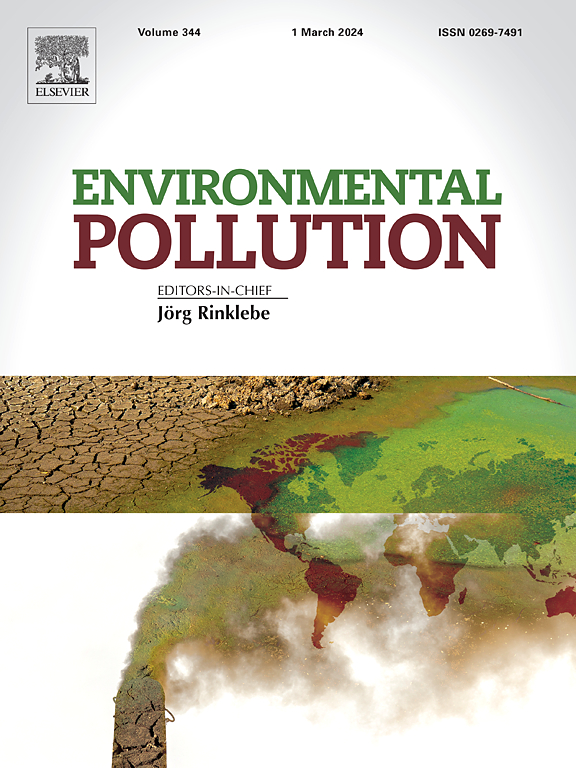妊娠期接触微塑料和纳米塑料会损害胎盘滋养细胞的合胞作用,从而导致妊娠结局不佳
IF 7.6
2区 环境科学与生态学
Q1 ENVIRONMENTAL SCIENCES
引用次数: 0
摘要
微纳米塑料(MNPs)作为一种新兴的环境污染物,因其对公众健康的潜在威胁而引起广泛关注。越来越多的证据表明,MNPs与不良妊娠结局密切相关,但其详细机制尚不清楚。在本研究中,我们首次发现母体在妊娠期间暴露于MNPs增加了胚胎吸收的数量和速度,同时减少了胚胎重量、胎盘直径和胎盘重量。在mnps处理的小鼠胎盘中,这伴随着黄体酮和雌二醇合成的中断。此外,我们的数据表明,MNPs暴露干扰胎盘发育,表现为胎盘总面积、海绵滋养层面积和迷路层面积的减少。随后,体内和体外实验进一步表明,MNPs破坏了小鼠胎盘和人胎盘滋养细胞的合胞过程,降低了合胞标记物的表达。进一步的研究表明,PERK/eIF2α/ATF4信号在mnps处理的小鼠胎盘和人胎盘滋养细胞中被激活。更重要的是,抑制PERK部分恢复了MNPs引起的合胞功能不足。总的来说,我们的研究结果表明,妊娠期暴露于MNPs可能通过激活PERK/eIF2α/ATF4通路干扰胎盘滋养细胞的合胞,导致胎盘异常和妊娠结局不良。本文章由计算机程序翻译,如有差异,请以英文原文为准。

Gestational exposure to micro- and nanoplastics leads to poor pregnancy outcomes by impairing placental trophoblast syncytialization
The omnipresent micro- and nanoplastics (MNPs), emerging environmental contaminants, have caused a widespread concern because of their potential threats to public health. Increasing evidence has indicated that MNPs were deeply involved in poor pregnancy outcomes, but the detailed mechanism remains obscure. In this research, we firstly identified that maternal exposure to MNPs during gestation increased both the number and rate of embryo resorption, while reducing embryonic weight, placental diameter and placental weight. This was accompanied by disrupted progesterone and estradiol synthesis in MNPs-treated mouse placentas. In addition, our data suggested that MNPs exposure disturbed placental development, as evidenced by the reduction of the total area of placenta, area of spongiotrophoblast layer and area of labyrinth layer. Subsequently, in vivo and in vitro experiments further indicated that MNPs compromised syncytialization process and decreased the expression of syncytialization markers in mouse placentas and human placental trophoblasts. Further investigation indicated that PERK/eIF2α/ATF4 signaling was activated in MNPs-treated mouse placentas and human placental trophoblasts. More importantly, inhibition of PERK partially restored syncytialization insufficiency caused by MNPs administration. On the whole, our results suggested that gestational exposure to MNPs disturbed placental trophoblasts syncytialization possibly through activating PERK/eIF2α/ATF4 pathway, resulting in aberrant placentation and poor pregnancy outcomes.
求助全文
通过发布文献求助,成功后即可免费获取论文全文。
去求助
来源期刊

Environmental Pollution
环境科学-环境科学
CiteScore
16.00
自引率
6.70%
发文量
2082
审稿时长
2.9 months
期刊介绍:
Environmental Pollution is an international peer-reviewed journal that publishes high-quality research papers and review articles covering all aspects of environmental pollution and its impacts on ecosystems and human health.
Subject areas include, but are not limited to:
• Sources and occurrences of pollutants that are clearly defined and measured in environmental compartments, food and food-related items, and human bodies;
• Interlinks between contaminant exposure and biological, ecological, and human health effects, including those of climate change;
• Contaminants of emerging concerns (including but not limited to antibiotic resistant microorganisms or genes, microplastics/nanoplastics, electronic wastes, light, and noise) and/or their biological, ecological, or human health effects;
• Laboratory and field studies on the remediation/mitigation of environmental pollution via new techniques and with clear links to biological, ecological, or human health effects;
• Modeling of pollution processes, patterns, or trends that is of clear environmental and/or human health interest;
• New techniques that measure and examine environmental occurrences, transport, behavior, and effects of pollutants within the environment or the laboratory, provided that they can be clearly used to address problems within regional or global environmental compartments.
 求助内容:
求助内容: 应助结果提醒方式:
应助结果提醒方式:


